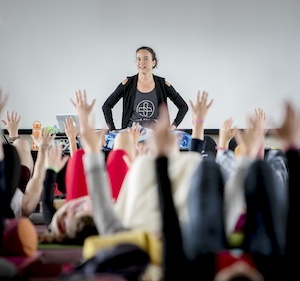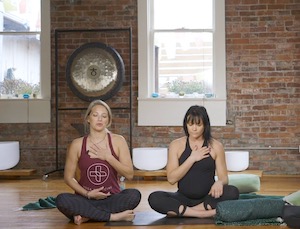Articles, In the Press, Rashmi Bismark, Resources, Yoga Medicine® News
Loving-Kindness Meditation for Kids
 Love is the Frequency: A Loving-Kindness Meditation for Kids
Love is the Frequency: A Loving-Kindness Meditation for Kids
My family finally got around to seeing Disney’s new fantasty/sci-fi adaptation of A Wrinkle in Time in the theater. Our girls were taken by the cinematic grandeur, all of the sparkles, and of course, the many main characters of color on the screen. Given our youngest daughter is convinced she is going to be a fashion designer/inventor of the first smart device with teleporting capabilities, this movie was a perfect spark for her imagination.
The story follows the family of a NASA scientist who discovers the ability to warp time and space with his consciousness. He travels billions of light years through the universe by attuning with the vibratory frequency of love. His discovery, the phenomenon of a universal “tesseract”, is able to manipulate sound and light. This creates an opening in the fabric of the time-space continuum, allowing him to “tesser” to other planets.
Unfortunately, the father gets stuck in a dark corner of the universe, and his children set off on a journey to help him get home. Without giving too much away, the children finally learn that to break free from the evil planet holding him captive and “tesser” back home, they need to tap their red glittery slippers together and…. Oh wait – oops, wrong movie!

Using Themes from A Wrinkle in Time
Back to A Wrinkle in Time – to get back to Earth, the main characters are challenged to be warriors for light and peace by: (1) feeling the “one-ness” of the universe while remaining true to their unique diverse qualities; (2) courageously confronting their darkness while staying connected to light; and (3) letting go of all resistance while vibrantly resonating with the innate frequency of love.
Though the ambitious movie is not without its own faults, its main message to young viewers of loving compassion for self and others is inspiring. In theory, the concepts sound good, but how does a kid exactly “align with the right frequency”, trust that “love is always there, even if you don’t feel it”, or recognize that it “isn’t gone; it’s just unfolded,” as the movie suggests? Perhaps it all starts with cultivating a relationship with love…
Loving-Kindness Meditation
Many contemplative traditions include practices that help to cultivate various innate positive character strengths and virtues of wellbeing, including love. Loving-kindness meditations are a perfect example.
Loving-kindness practices carry the intention of nurturing a relationship with the shared human capacity for love. They ask us to attend carefully to the embodiment of love that arises as we open our hearts to our selves and others with curiosity, interest, and patience. Research suggests that engagement in such practices can be a source of harmony and health.
Meditations on loving-kindness can begin by feeling into sensations within the body and heart space. They explore inviting a sense of loving friendship by bringing to mind a loved one for whom it is easy to generate such tender feelings. Holding this invitation to love, practices attend to the embodied experience through noticing shifting sensations, thoughts, and emotions as they unfold.
Resting within the awareness of loving presence, the focus of practice then centers back upon one’s self to nurture the natural capacity for self-love and self-compassion. Practices often close by expanding attention to include others – sending out wishes for love, peace, and prosperity to family, community, and even the world beyond.
Feelin’ All the Feels
Younger children are more inclined to be open to the idea of feeling into their heart and generating love. The younger they are, the more freely they tend to give and accept love. When sharing these practices with little ones, sometimes just a few questions can uncover a range of experiences. We are allowing children to freely explore how love feels within their bodies, minds, and hearts. After a few calming cycles of breath, you may consider the following:
- What do you notice happening in and around your chest, in the space of your heart? What does the love in your heart feel like? Does it have a color or a temperature? Does it tingle or tickle? Is it still? Can it move through your body? What is that like? How does it make you feel? What do you notice in the rest of your body? Are any thoughts, pictures, or memories coming to mind?
When sending love to others, children may call upon the memory of any loved one. It may be a person, a pet, a plant, a stuffed toy, someone living, a family member who has passed – allow them to be creative.
- As you feel even more into love, is there anyone you are reminded of that brings a smile to your heart or that you would like to send a little love to? Can you let the love from your heart shine out towards them, like the sun shines its light to the Earth? What does it feel like to share love with them like this? What wishes do you have for them? Can you let them send some love back to you? What do you notice happening now in your body, heart, and mind?
Using Universal Prayers
Children who are in their tween years and beyond may need a bit more guidance when exploring loving-kindness practices in this way. Feeling into the body can be more challenging, while shifting emotions can be harder to define. Even if it is difficult for them to connect with the presence of love, often helping them stay open to the intention for love, well-being, and peace can be enough.
Mantras or affirmations may be used to encourage a relationship with loving intentions for self and others. These phrases are focusing tools that help build a connection with the “felt-sense” or embodiment of their words. Universal prayers for love and peace exist in many wisdom traditions. A simple yet powerful suggestion comes from renowned Western Buddhist teacher, Sharon Salzberg.
- May I/(you/we) be safe.
- May I/(you/we) be happy.
- May I/(you/we) be healthy.
- May I/(you/we) be peaceful and live with ease.
If the exact wording doesn’t make sense for you, or if English is not your preferred language, feel free to use whatever word(s) speak to you. Truly honoring one’s self and others requires the ability to draw upon attitudes of trust, patience, compassion, as well as a willingness to allow for mistakes and building resilience. The words you or your child choose may shift and change, but the intention for connection with loving presence remains.
Wrinkling Time
Watching the journey of Meg, the main character in A Wrinkle in Time, certainly transported me back to memories of adolescence and the general awkwardness of it all. It also reminded me of a Sanskrit universal prayer for well-being and peace that I learned back in my youth[i]. At that time, I really did not grasp the depth of meaning behind its words. I have been revisiting it these days in my own house during loving-kindness practices with my older daughter. She will be joining the ranks of tween-dom very soon.
Below is an offering of our current interpretations of what it means for us in the context of cultivating loving-kindness. (For anyone interested, the Sanskrit words are in the endnotes.)
- May I move beyond all false ideas about myself to clearly see and be friends with who I truly am;
- May I be kind to myself as I bravely walk through dark fears and challenges by opening to light and luminous love;
- May I break free from anything that keeps me stuck or holds me back as I continue to learn, grow, and flourish in the sweetness of life;
- May I feel peace, be peace from within, and share peace with the whole universe around me.
Whether or not you choose to explore any of this, either for yourself and/or with the children in your life, we are sending you wishes for boundless love and peace.
So can the vibration of love really allow us to travel through space and time?
That was a question hotly debated in the car on the way home from the movies. Our youngest declared, “Well I can feel Grandpa and Appuppa (grandfather) whenever I send them love during prayers at night. I can see them in my heart. I can feel them smiling at me. And they don’t live here any more. So I’m going to say – YES.”
Footnotes:
[i] asato ma sat gamaya; tamaso ma jyotir gamaya; mrityor ma amritam gamaya; om shanti, shanti, shanti – From untruths to truth, may I be led; From darkness to light, may I be led; From death/limitations to the sweet nectar of immortal life, may I be led; Universal peace, peace, peace. Brhadaranyaka Upanishad (1.3.28)














